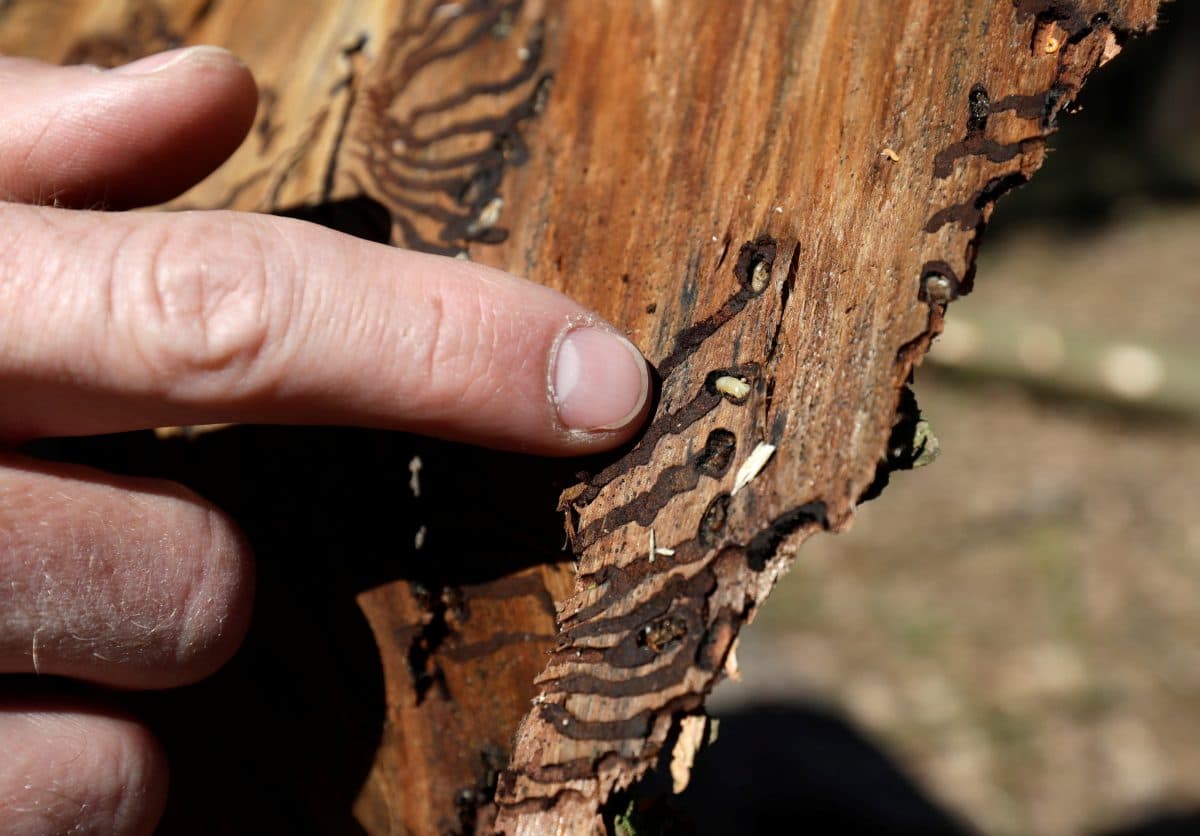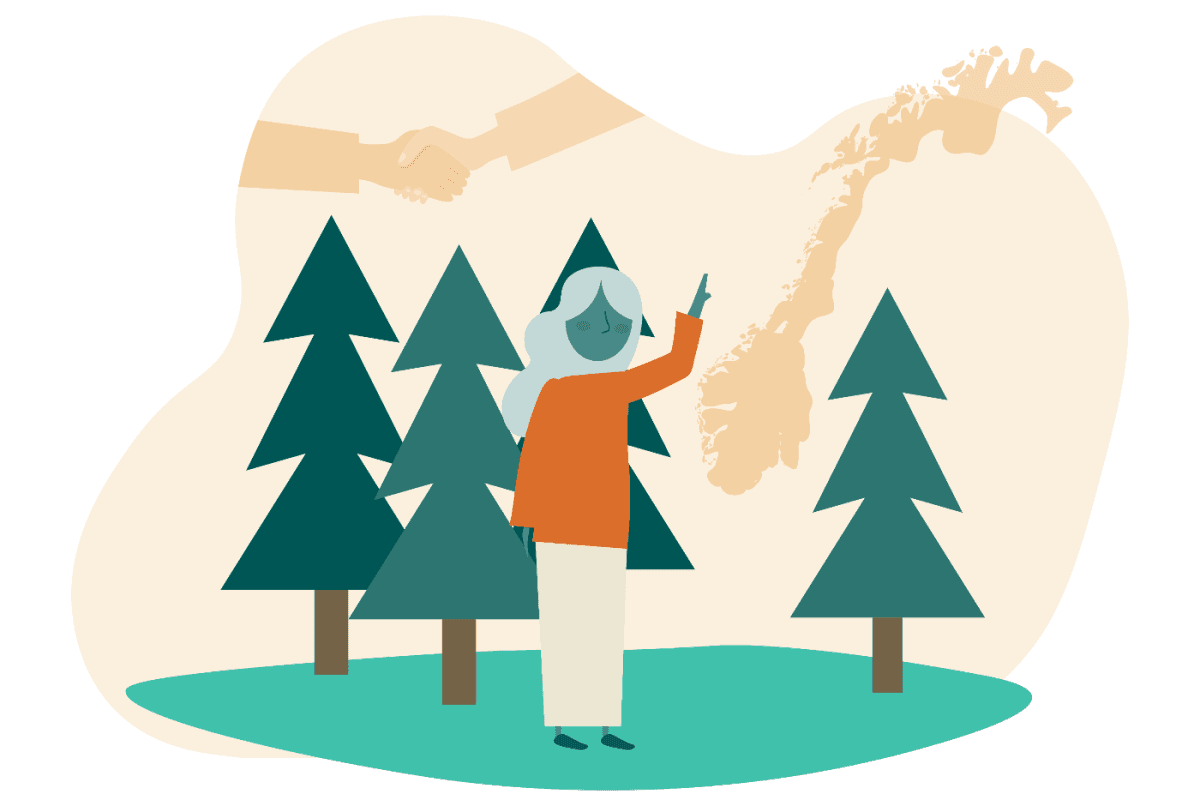What’s going on with the forest sink?
CO₂ absorption by our forests is no longer what it used to be, and Norway isn’t alone in facing this issue. We ask climate researcher Glen Peters what’s happening.

A forest researcher points at a bark beetle near the village of Markvartice, Czech Republic, April 5, 2019. Photo: David W Cerny/Reuters/NTB
Do you remember the argument that including forest carbon uptake in climate targets, as the EU does, would benefit Norway? The reasoning was that if Norway, like some other countries, counted forest uptake in its climate goals, it would put us much closer to meeting our 2030 targets due to our extensive forested areas.
Critics of this approach warned of two major pitfalls. Firstly, it would go against the Paris Agreement, raising the paradox of breaking an agreement to meet its goals. Secondly, they highlighted that the seemingly vast forest uptake isn’t guaranteed to last. In fact, it could reverse, with forests potentially becoming a source of emissions.
Vil du heller lese norsk?
Det kan du, klikk her for en norsk oversettelse av dette intervjuet!
This prediction has come true in several countries. Forest carbon uptake shows a negative trend across much of Europe, particularly in the northern regions, including Norway. In the Czech Republic, the forest has been a net emitter for years following severe bark beetle outbreaks. Finland’s forest sink has also declined, and in countries like Norway, Sweden, and Germany, the situation is worse than it once was.
We spoke with Glen Peters of CICERO, who is also affiliated with the Global Carbon Project, which tracks greenhouse gas emissions and CO₂ absorption worldwide.
<2°C: – So, the big question is, is now a good time to start panicking about the forest uptake globally, or is this just a fluke? What’s going on?
Glen Peters: – I’d lean towards the panic, but it’s more about what we should do about this. There was the article in The Guardian the other week, and coincidentally, another article got published recently. They both talk about the global land sink being weak in 2023, and there were some other articles earlier in the year stating the same. In a sense, yes, the sink was weaker in 2023, but we expect that in an El Niño year.
The global aggregate sink is one issue, but another element is what’s happening with the sink in Europe, and whether we should be worried about that. When you mention Finland and Norway, yes, we should be worried, and we need to reconsider the policy framework around the land sector.
– But how did this happen, why did we not see it coming?
– One of the reasons is that the science hasn’t kept up with the issue. Many models don’t account for disturbances. It’s like with climate: You can’t predict exactly when or where a cyclone will hit. The same goes for bark beetles or droughts.
Take forward looking forest models, like those from NIBIO, they tend to be almost blind to things like droughts, and bark beetles. They look back in time, and when they model forward, they’re not accounting for these risks. They assume everything is fine—you harvest a tree, it grows back—but we need to rethink those assumptions. And, therefore, we need to rethink the role of forestry in the land sector.
– Let’s get back to that. But what you mentioned about not accounting for risk a problem in many models, isn’t it? And scientists have pointed out that a lot of models have a difficulty in incorporating certain types of risks, which are hard to predict exactly when and how often will happen but still impact the sector significantly when they do.
– Yes, you could say that.
– So are we seeing now what people warned against—that these models don’t pick up on these things, and that we are actually far worse off than we have imagined?
– There’s a lot of debate about this. There was a paper in 2013— “The first signs of saturation in the European land sink”. So even back then, forestry experts were talking about the first signs of carbon sink saturation in European forests.
– Explain «saturation” in this context.
– It means the forests are reaching a point where they can no longer absorb as much carbon as they used to. Which, as I mentioned, was actually noticed back in 2013 by forestry experts. Roll forward to today, and we see satellite data showing increased harvested areas in Europe. There was skepticism around this at first, but if you look at today’s data, it seems they were correct.
The advantage of satellite data is that it provides more immediate information. In contrast, forest inventories like NIBIO’s update much more slowly—only 20% of the forest is inventoried each year. They can yield high quality data, but they can be slow in noticing these changes. So, the data we’re getting now reflects what happened some years ago, and in some cases, you only see the signals when it’s too late.
– They are starting to notice now, though. And it has been showing up in the inventories. So what is being done?
– Politically, we’re seeing Finland start to discuss changes in harvest policy to reduce harvest levels, as it’s a bigger issue there. In Norway, it’s other factors. Depending on what happens with the sink over the next couple of years, Norway will face some tough questions too. This links into the NDC discussions, with the white paper on how to incorporate LULUCF in the targets.
– You are talking about the new climate law proposal?
– Exactly. It’s becoming more relevant as people start to notice, but there’s been a delay in action. Models haven’t kept up, they’re not good at estimating future uptake. And they are trying to figure out how to make them better. There is actually a project now comparing NIBIO’s models with process-based models, looking at disturbance factors.
– But enough about Norway. If we step back, is this a problem across large parts of the world, or is it more localized in Northern Europe?
– It’s a wider problem. In the US and Europe, there’s robust data that shows a similar decline in the trend. But in developing countries, where the data is less comprehensive, you need to rely on other sources. Globally, the land sink has slowed down in the last decade, though emissions have also slowed. So, when you look at the ratio between emissions and the sink, the airborne fraction, it has remained constant. If that ratio starts to change, it would mean more of the emissions stay in the atmosphere, potentially accelerating climate change. But that hasn’t happened. This raises questions at the global level, but at the EU level, it’s clear there’s been a big change in disturbance and harvest patterns.
– And people are now pointing to what happened in Canada 30 years ago. Explain.
– Yes, Canada saw a big bark beetle attack in the 1990s, which affected 50% of the commercial pine in British Columbia. No one expected it to happen there, and now we’ve seen similar patterns in Europe, like in Germany and The Czech Republic, with bark beetles and droughts combining to weaken their sink.
– So what can be done about it?
– Reducing harvest is one option. In Finland, they’re discussing it, but it’s politically challenging. In Norway, with so many private forest owners, regulating harvest is difficult. The forest industry often argues that harvesting helps increase the sink by allowing young trees to grow, but this is debatable. And of course, limiting harvest would raise timber prices and impact industries like construction.
– So, the land sink is looking iffy globally. How about the ocean sink?
– The ocean sink is less variable and more dependable, though it has also started to slow down slightly. There’s debate on whether this is climate-driven or caused by other factors, but it’s less of an immediate concern compared to the land sink.
